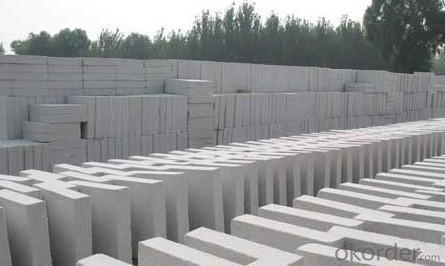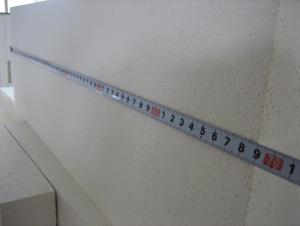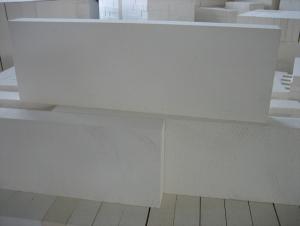Refractory Mullite Insulating Refractory Brick JM 36
- Loading Port:
- Shanghai
- Payment Terms:
- TT OR LC
- Min Order Qty:
- 20 m.t.
- Supply Capability:
- 20 m.t./month
OKorder Service Pledge
OKorder Financial Service
You Might Also Like
General Information
CMAX insulating firebricks are classified under temperature between 1300℃ to 1700℃, manufactured from high purity alumina clay.
1. Lower content of iron, alkaline and impurities, good high temperature properties.
2. Homogeneous structure, light weight, energy saving because lower heat storage in the furnace during cooling cycles.
3. High strength, good thermal shock resistance under high temperature.
4. Precise sizes due to grinding and shaping after sintering, which meets the requirement of construction.
5. Max service temp: Up to 1730C (3160F)
Feature
Light weight and low thermal conductivity
Low heat storage
Low iron and impurities
High thermal shock resistance
Application of Insulating brick
Metallurgical Industry: blast furnace, hot blast furnace, heating furnace, etc..
Petrochemical Industry: ethylene cracking furnace, hydrogen furnace, the main furnace, heating furnace, etc..
Ceramic industry: roller kiln, kiln, etc..
Glass industry: glass furnace regenerator, etc.
Carbon industry: carbon furnace, etc..
Aluminum electrolysis industry: aluminum reduction cell, etc.
Other industries: tunnel kiln, shuttle kiln, etc.
Advantages of heat insulation brick
Low thermal conductivity: many air holes will bring good thermal insulation effect, energy saving.
High crushing strength: high crushing strength, volume stability.
Low heat storage: small heat storage, absorb more heat, energy-saving effect is obvious.
Technical Data
ITEM | GJM30 | GJM28 | GJM26 | GJM23 |
Classification Temperature, ℉/℃ | 3000/1650 | 2800/1540 | 2600/1430 | 2300/1260 |
Bulk Density,g/cm³ | ≤1.0 | ≤0.9 | ≤0.8 | ≥0.5 |
Reheating Linear Change, % | ≤0.9 (1550℃,12 h) | ≤0.8 (1510℃,12 h) | ≤0.7 (1410℃,12 h) | ≤0.5 (1230℃,12 h) |
Al2O3 Content, % | ≥75 | ≥65 | ≥55 | ≥45 |
Fe2O3 Content, % | ≤0.5 | ≤0.6 | ≤0.7 | ≤1.0 |
Thermal Conductivity: | ||||
800℃, w/m.k | ≤0.39 | ≤0.37 | ≤0.35 | ≤0.18 |
1000℃, w/m.k | ≤0.43 | ≤0.41 | ≤0.39 | ≤0.20 |
1200℃, w/m.k | ≤0.48 | ≤0.46 | ≤0.43 | --- |
Insulating brick

- Q:Are insulating fire bricks suitable for insulation in walls?
- Typically, insulating fire bricks are unsuitable for wall insulation. Although they excel in high-temperature settings, like furnaces or kilns, their insulation capabilities for walls are limited. Insulating fire bricks possess lower thermal conductivity than regular bricks, resulting in slower heat conduction. Nevertheless, they are not as effective as wall-specific insulation materials such as fiberglass, foam boards, or mineral wool. These materials are engineered to offer superior insulation properties, including higher R-values that measure resistance to heat transfer. Furthermore, insulating fire bricks tend to be pricier and heavier compared to other insulation options, making them less practical for wall insulation. Therefore, while insulating fire bricks do have advantages in certain applications, they are generally not the optimal choice for wall insulation.
- Q:What are the main properties of insulating fire bricks?
- IFBs, also known as insulating fire bricks, possess a variety of properties that make them perfect for different high-temperature uses. Firstly, their thermal insulation properties are excellent. They have a low thermal conductivity, meaning they effectively prevent heat transfer. This characteristic makes them ideal for environments where insulation is crucial, such as kilns, furnaces, and industrial ovens. The low thermal conductivity of IFBs helps to minimize heat loss and maintain high temperatures within these structures. Another important property of IFBs is their high refractoriness. They can endure extreme temperatures without losing their structural integrity. IFBs can withstand temperatures of up to 3000°F (1650°C), making them suitable for use in extremely hot environments. This high refractoriness allows them to be used in applications that involve the containment of molten metals, glass, or other materials at elevated temperatures. Furthermore, IFBs are lightweight and have a relatively low bulk density. This lightweight nature makes them easier to handle and install, reducing the labor and cost involved in construction or maintenance projects. The low bulk density of IFBs also contributes to their excellent thermal insulation properties as it reduces the number of air pockets within the material, thereby minimizing heat transfer. Additionally, IFBs have good chemical resistance. They are highly resistant to chemical attack from various substances, including acids, alkalis, and other corrosive agents. This property allows IFBs to maintain their structural integrity even in harsh chemical environments, making them suitable for applications in industries like chemical processing, metal refining, and incineration. Finally, IFBs are known for their durability and long lifespan. They have excellent mechanical strength and can withstand thermal cycling, meaning they can endure repeated exposure to extreme temperatures without cracking or breaking. This longevity makes them a cost-effective choice for applications where durability and reliability are paramount. In summary, the main properties of IFBs include excellent thermal insulation, high refractoriness, lightweight structure, good chemical resistance, and durability. These properties make IFBs suitable for a wide range of high-temperature applications, providing efficient insulation, protection against extreme temperatures, and long-lasting performance.
- Q:Can insulating fire bricks be used in lime plants?
- Yes, insulating fire bricks can be used in lime plants. They are commonly used in high-temperature applications, such as lime kilns, to provide thermal insulation and reduce heat loss. Insulating fire bricks help maintain consistent and efficient heat distribution, which is essential for the lime production process.
- Q:Can insulating fire bricks be used as a lining for boilers?
- Yes, insulating fire bricks can be used as a lining for boilers. Insulating fire bricks are designed to withstand high temperatures and have excellent thermal insulation properties. They are commonly used in applications where heat retention and energy efficiency are important, such as in industrial boilers. The insulating properties of these bricks help to reduce heat loss and increase the efficiency of the boiler. Additionally, their durability and resistance to thermal shock make them suitable for use in boiler linings, where they can withstand the extreme conditions and fluctuations in temperature.
- Q:Do insulating fire bricks require any special tools for installation?
- No, insulating fire bricks do not require any special tools for installation. They can be easily installed using standard masonry tools such as a trowel and mortar.
- Q:Can insulating fire bricks be used in incinerators?
- Indeed, insulating fire bricks can be utilized in incinerators. These bricks are specifically crafted to offer exceptional thermal insulation, rendering them perfect for scenarios where elevated temperatures must be sustained. By incorporating insulating fire bricks into incinerators, which function at exceedingly high temperatures, heat loss can be minimized and the system's overall energy efficiency can be enhanced. Furthermore, these bricks possess commendable resistance against thermal shock, a critical characteristic in incinerators subject to sudden temperature fluctuations. Consequently, the utilization of insulating fire bricks in incinerators can significantly augment their performance and durability.
- Q:Can insulating fire bricks be used in the construction of industrial boilers?
- Yes, insulating fire bricks can be used in the construction of industrial boilers. These bricks are designed to withstand high temperatures and provide excellent insulation, making them ideal for use in boiler systems where heat retention and efficiency are crucial. They help to prevent heat loss and ensure efficient energy transfer, making them a popular choice for industrial boiler applications.
- Q:Can insulating fire bricks be used for insulation in glass manufacturing?
- Insulation in glass manufacturing can be achieved using insulating fire bricks. These bricks are specifically designed to possess exceptional thermal insulation properties, a high resistance to heat, and low thermal conductivity. These qualities make them well-suited for situations where the maintenance or control of high temperatures is necessary, such as in glass manufacturing processes. The implementation of insulating fire bricks in glass manufacturing contributes to the reduction of heat loss and the enhancement of energy efficiency. By insulating the furnace or kiln, these bricks prevent excessive heat from escaping, resulting in a decreased energy requirement to sustain the desired temperature. This not only leads to savings in energy costs but also facilitates the establishment of a more stable and regulated environment for the glass manufacturing process. Moreover, insulating fire bricks possess the ability to endure the extreme temperatures typically encountered during glass manufacturing, thus making them a dependable choice for insulation. With a capacity to withstand temperatures reaching up to 3000 degrees Fahrenheit (1650 degrees Celsius), these bricks remain structurally intact and effective in their insulation function within the furnace or kiln. To summarize, the exceptional thermal insulation properties, high heat resistance, and low thermal conductivity of insulating fire bricks render them a suitable option for insulation in glass manufacturing. Their implementation aids in the enhancement of energy efficiency, the maintenance of stable temperatures, and the creation of a controlled environment for the glass manufacturing process.
- Q:Are insulating fire bricks resistant to high-pressure environments?
- Yes, insulating fire bricks are generally resistant to high-pressure environments. These bricks are designed to withstand high temperatures and are often used in applications where pressure is present, such as in kilns, furnaces, and industrial boilers. They have excellent thermal insulation properties and can maintain their structural integrity under significant pressure.
- Q:Are insulating fire bricks suitable for use in glass furnaces?
- Yes, insulating fire bricks are indeed suitable for use in glass furnaces. These fire bricks are specifically designed to withstand high temperatures and provide excellent thermal insulation. They help to maintain consistent heat levels within the furnace, prevent heat loss, and reduce energy consumption. Additionally, insulating fire bricks are resistant to chemical reactions and can withstand the corrosive environment of a glass furnace.
1. Manufacturer Overview |
|
|---|---|
| Location | |
| Year Established | |
| Annual Output Value | |
| Main Markets | |
| Company Certifications | |
2. Manufacturer Certificates |
|
|---|---|
| a) Certification Name | |
| Range | |
| Reference | |
| Validity Period | |
3. Manufacturer Capability |
|
|---|---|
| a)Trade Capacity | |
| Nearest Port | |
| Export Percentage | |
| No.of Employees in Trade Department | |
| Language Spoken: | |
| b)Factory Information | |
| Factory Size: | |
| No. of Production Lines | |
| Contract Manufacturing | |
| Product Price Range | |
Send your message to us
Refractory Mullite Insulating Refractory Brick JM 36
- Loading Port:
- Shanghai
- Payment Terms:
- TT OR LC
- Min Order Qty:
- 20 m.t.
- Supply Capability:
- 20 m.t./month
OKorder Service Pledge
OKorder Financial Service
Similar products
New products
Hot products
Related keywords



























